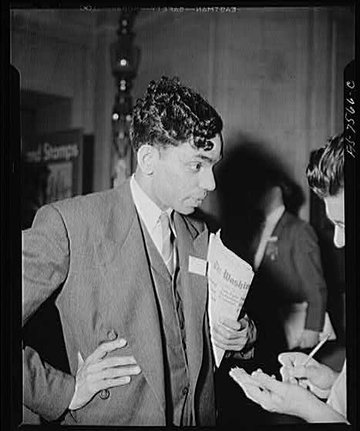
Subrahmanyan Chandrasekhar
‐
Mathematician and astrophysicist
Place of birth
Date of arrival to Britain
Location(s)
CB2 1TQ
United Kingdom
Place of death
Chicago, US
Date of time spent in Britain
1930–7
About
Subrahmanyan Chandrasekhar was an applied mathematician and astrophysicist. He completed his university education at Presidency College, Madras, graduating with a Bachelor of Science degree in physics. In June 1930 he moved to Britain for postgraduate studies. He was awarded a Government of India scholarship to study at Cambridge as a member of Trinity College, where he became a research student under the supervision of Professor R. H. Fowler. He took his PhD degree at Cambridge in the summer of 1933. In October 1933 he was awarded a Prize Fellowship at Trinity College for the period 1933–7. He joined the faculty of the University of Chicago in 1937 and remained there for the rest of his academic career.
He made one of his most significant discoveries, called ‘Chandrasekhar's limit’, while on his way to England. He applied Einstein’s theory of relativity to the processes inside a star. His calculations suggested that once a star had burned up all its energy it would collapse to a point of infinite density, until it disappeared in what would be later described as a black hole. On his arrival in Cambridge, however, his colleagues paid little attention to his discovery. Arthur Eddington took great interest in Chandrasekhar’s work, and it looked as though he approved of his work. He persuaded Chandrasekhar to present his findings at the Royal Astronomical Society in London on 11 January 1935. The day before the event, he found out that Eddington would give the following lecture on the same topic. Eddington used the opportunity to demolish the young researcher’s calculations and theory, dismissing them as mere mathematical game-playing. However, while Chandrasekhar’s work was based on sound mathematical calculations, Eddington’s argument was in this case unfounded.
It would take years before scientists would follow up Chandrasekhar’s calculations and the controversy would preoccupy scientific journals for several years. In 1966 scientists combined computer codes for astrophysics and the hydrogen bomb and proved that a star could collapse and fall into a black hole. In 1972 the first black hole was positively identified. Chandrasekhar's outstanding contribution to astrophysics was acknowledged with the 1983 Nobel Prize in Physics for his work on white dwarfs and black holes and in 1984 by the Royal Society's Copley Medal.
Professor P. A. M. Dirac, Arthur Stanley Eddington, R. H. Fowler, E. A. Milne.
Royal Astronomical Society London
An Introduction to the Study of Stellar Structure (Chicago: University of Chicago Press, 1939)
Principles of Stellar Dynamics (Chicago: University of Chicago Press, 1942)
Radiative Transfer (Oxford: Clarendon Press, 1950)
The Illumination and Polarization of the Sunlit Sky on Rayleigh Scattering (Philadelphia: American Philosophical Society, 1954)
Plasma Physics (Chicago and London: University of Chicago Press, 1960)
Hydrodynamic and Hydromagnetic Stability (Oxford: Clarendon Press, 1961)
Ellipsoidal Figures of Equilibrium (New Haven, CT and London: Yale University Press, 1969)
Liquid Crystals (Cambridge: Cambridge University Press, 1977)
The Mathematical Theory of Black Holes (New York: Oxford University Press, 1983)
Eddington: The Most Distinguished Astrophysicist of his Time (Cambridge: Cambridge University Press, 1983)
Truth and Beauty: Aesthetics and Motivations in Science (Chicago: University of Chicago Press, 1987)
Selected Papers (Chicago: University of Chicago Press, 1989)
Relativistic Astrophysics (Chicago: University of Chicago Press, 1990)
Newton's Principia for the Common Reader (Oxford: Clarendon Press, 1995)
Mestel, Leon, ‘Chandrasekhar, Subrahmanyan (1910–1995)’, Oxford Dictionary of National Biography (Oxford University Press, 2004) [http://www.oxforddnb.com/view/article/57771]
Miller, Arthur I., Empire of the Stars: Friendship, Obsession, and Betrayal in the Quest for Black Holes (London: Little Brown, 2005)
Odelberg, Wilhelm (ed.) The Nobel Prizes 1983 (Stockholm: Nobel Foundation, 1984)
Srinivasan, G. (ed.) From White Dwarfs to Black Holes: The Legacy of S. Chandrasekhar (Chicago: University of Chicago Press, 1997)
Venkataraman, G., Chandrasekhar and His Limit (London: Sangam, 1992)
Wali, Kameshwar C., Chandra: A Biography of S. Chandrasekhar (Chicago: University of Chicago Press, 1991)
Wali, Kameshwar C. (ed.) Chandrasekhar: The Man Behind the Legend – Chandra Remembered (London: Imperial College Press, 1997)
Wignesan, T. (ed.) The Man Who Dwarfed the Stars (Asianists' Asia, 2004)
Image credit
Library of Congress, Prints & Photographs Division, FSA/OWI Collection, LC-USW3- 007566-C
